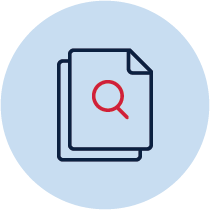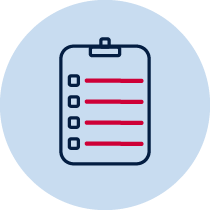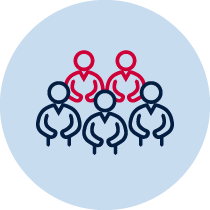Programming guide
About programming
Programming helps deliver differentiated and successful teaching and learning opportunities so that all students can be fully included in classrooms and other learning environments in schools. Choosing a consistent, methodological approach to understanding students and their individual abilities and support needs is key to programming for all students. Proactive programming that includes curriculum, teaching strategies, adjustments and opportunities for participation can increase the capability of schools to assist all students to learn.
The teaching and learning cycle also helps inform this process. Each step in the cycle provides teachers and schools opportunities for ongoing reflection through a series of critical questions. This can lead to fundamental shifts in programming and planning to achieve differentiated learning experiences for all students.

1. Identify scope
The first stage of programming typically involves analysing the curriculum to identify key syllabus outcomes, and setting goals. Consideration of each student’s interests, strengths, abilities, readiness, learning profiles and cultural identity can inform each of these processes, and helps develop priorities and goals that are challenging, interesting and engaging for students.
Whole-school curriculum planning helps prioritise and make decisions about which syllabus outcomes will be addressed across classes. Further analysing the curriculum to differentiate for a specific class or cohort often involves asking questions such as:
- What are the key syllabus outcomes for these students?
- What do students need to learn outside the curriculum?
Breaking down the key knowledge, concepts, principles, and skills for students to acquire helps inform goal setting that can be tailored to the strengths and abilities of individual students.
Setting challenging and attainable long-term goals (yearly and beyond) and short-term goals (unit/learning sequence) is an important step in identifying priorities that inform how teachers may plan and program. Collaborative curriculum planning is the process to determine the most appropriate curriculum options and adjustments for a student with disability. It involves collaboration between teachers, the learning and support team, the student, their family and other key stakeholders.
See it in action
In this case study, a Year 6 class teacher plans a unit of work for the Number and Algebra Strand (Substrand: Multiplication and Division). The teacher refers to recent and previous assessments to determine the starting point for instruction, including for one student who has gaps in his background knowledge and skills within the Mathematics Syllabus. The teacher uses the evidence of learning from assessments to select outcomes and content for the class. Download NESA case study 2 (DOC 1.4MB)
In this case study, a Year 5 class teacher plans a unit of work for the Statistics and Probability Strand (Substrand: Data). Recent and previous assessments indicate students can be grouped into three tiers for the learning experience. The teacher identifies the content and relevant outcomes for each of these three tiers to provide differentiated learning experiences. Download NESA case study 4 (DOC 942.9KB)

2. Identify sequence
Identifying the sequence, that is, the specific order, repetition, and arrangement of syllabus outcomes, can result in a learning program that supports students to consolidate their learning through opportunities to apply new skills or knowledge across multiple contexts. Repetition of key skills or knowledge across key learning areas can be particularly helpful for students with disability. Further, careful consideration of student strengths, abilities and readiness can inform the order and arrangement of the syllabus.
Collaboration between teachers and the learning and support team during sequencing can help create programs that provide consistency for students that help them achieve their learning goals and generalisation of the skills they have learned. When planning learning intentions, formative and summative assessments, and instructional objectives, consider how student characteristics, including reports or information included in students’ personalised learning and support plans, may inform the flow and sequencing of these activities.
Key questions that may be helpful include:
- what opportunities are there for repetition across key learning areas?
- what order shall I teach new concepts in?
- how much time will be allocated for different components for this student and others in the classroom?
- at what stages will formative assessment be most helpful for determining next steps?
- what types of assessment tasks are going to be planned so students are able to demonstrate their knowledge and understanding of the curriculum?
Task analysis can be a helpful tool for teachers to use in breaking down how many steps are in a task or activity. Task analysis can also provide valuable information about where a student needs additional support or adjustments within tasks. Understanding and recognising the sequence of steps involved for an individual student to complete a task and any prerequisite activities or experiences for that student to have achieved beforehand aids teachers in not only planning for sequencing overall, but within tasks themselves.
See it in action
In the earlier case study of a Year 5 teacher, after selecting syllabus content, the teacher identifies teaching strategies for the learning and assessment opportunities, and plans tiered learning experiences.
Reflection
How does the sequencing consider student characteristics? Can you identify where there are opportunities for repetition across key learning areas? Are there changes you would make to the sequencing to further tailor the approach for the student’s characteristics?

3. Plan lessons and learning experiences
Flexibility, creativity, collaborative planning, and careful consideration of student characteristics are important for planning for differentiated lessons and learning experiences. This will usually include planning how to provide learning activities that include curriculum, instructional and environmental adjustments for individual students, as identified in their personalised learning and support plan.
Making connections to students’ prior learning by understanding previous learning opportunities they have had at the school and beyond supports teachers to create authentic and meaningful teaching and learning opportunities for students. When planning for individual learning, teachers must reflect on whether goals and learning experiences offered to the class or individual are pragmatic and attainable.
For example, if written work is a barrier to a student’s participation, consider providing opportunities for them to instead engage in the same content using speech to text software, hands-on tasks, or verbal responses.
See it in action
In the earlier two case studies, teachers identify a range of adjustments to differentiate lessons for students. These adjustments draw on student personalised learning and support plans, as well as assessments.
Reflection
Looking at the adjustments identified for each student prior to programming (through collaborative curriculum planning or in discussion with the student), identify how these were put into action when planning learning experiences. Can you think of other opportunities to apply these adjustments within the learning experiences?

4. Design assessments and achievable tasks
Teachers can use assessment to guide decision making in teaching and future programming. Formative assessments can help identify further adjustments or differentiation opportunities to support student engagement, comprehension and achievement.
Assessment that is focused on understanding where the class currently is and where they are expected to develop requires deliberate and intentional assessment that regularly appraises students’ understanding and achievement. Use of mastery learning, when teachers allow enough time for students to understand the concepts being focused on, is founded on the basis that learning is cumulative.
When designing both formative and summative assessments, consideration of the adjustments that best support student learning is key. For example, if a student typically learns through time-limited, hands-on activities, providing opportunities for time-limited assessments or practical assessment tasks can assist teachers to establish where the student is in their learning and further learning progress can be monitored over time.
Providing choices in assessment modalities is one way in which differentiated assessment can be offered. Key questions that may be helpful when planning assessments include:
- In what ways are there opportunities for student self-assessment?
- What are the ways that students can take charge of key aspects of their own learning to support deeper levels of engagement?
- How do the students in my class typically engage in their assessment as learning?
See it in action
An example of choices provided in assessment modalities is provided here through with a primary school teacher working with Darcy, a 9-year-old diagnosed with cerebral palsy. Darcy is given more time to fulfill in-class assessment tasks and given the option of using a laptop for written tasks. Darcy typically prefers to use an ergonomic pen for handwriting. Read more about Darcy's story on NCCD's website.

5. How to teach to maximise learning?
The process of actively teaching and providing learning experiences for students involves a number of interlinked and dynamic steps. Teachers implement planned differentiated learning activities, including planned adjustments for individual students. These adjustments should be strengths- and evidence-based. Effective delivery of planned adjustments requires clear communication and understanding of how teachers, and SLSOs when relevant, can work together.
Ongoing monitoring of student progress, including through formative assessments, is needed to ensure adjustments are effective. This includes seeking the student’s views on whether the learning materials and adjustments are still suitable and effective. Teachers may need to modify their approach to adjustments or planned learning activities in response to this monitoring process.
One key question to ask during this stage is - are individual students receiving too little or too much support for specific tasks or contexts?
See it in action
In this example, a Year 6 class teacher offers captions in videos and visual supports to supplement the captions. This ensures Raqiya, a Year 6 student diagnosed with a mild hearing impairment and is having difficulty with language, is supported to develop her reading skills. Read more about Raqiya's story on NCCD's website.
In this video you will see how one secondary school teacher provides Ted, a Year 7 student on the autism spectrum, with a clear order of instructions to follow. To provide consistency she repeatedly uses colour coding to support him to categorise different concepts. Read more about Ted's story on NCCD's website.
See it in action
In this video one secondary teacher breaks down key knowledge and concepts that students will use in understanding a particular concept in grammar.
She asks all students to find a specific section in their workbook, reads the instructions out loud, and asks Mitchell, a Year 9 student, to explain out loud what a ‘run-on sentence does’.
This checks Mitchell’s understanding of this grammatical task. Read more about Mitchell's story on NCCD's website.

6. Reflect, evaluate and modify approach
Ongoing critical reflection and evaluation of student progress, and the implementation of modifications to future learning activities and programming, is an essential process for delivering effectively differentiated learning experiences.
Communication between teachers, SLSOs, the student, the Learning and Support Team, the student’s family, and other key stakeholders, can help identify how adjustments can be modified, and strengthen everyone’s understanding of a student’s strengths, abilities and preferences. This strengthened understanding may help inform further development of the student’s personalised learning and support plan, as well as future programming.
See it in action
Here's an example of how a school worked in partnership with a student’s family and allied health professionals to regularly reflect, evaluate and modify the program. Read Zac's story on NCCD's website.
School Excellence Framework alignment
Wellbeing
Australian Professional Standards for Teachers alignment
Standard 1: Know students and how they learn
Audience
School leaders and primary teachers
Purpose
This guide supports teachers to work through a range of considerations when differentiating teaching programs. This guide includes links to examples to further inform practice.
Reviewed
November 2021. Share your feedback here
Explore other topics
1/4